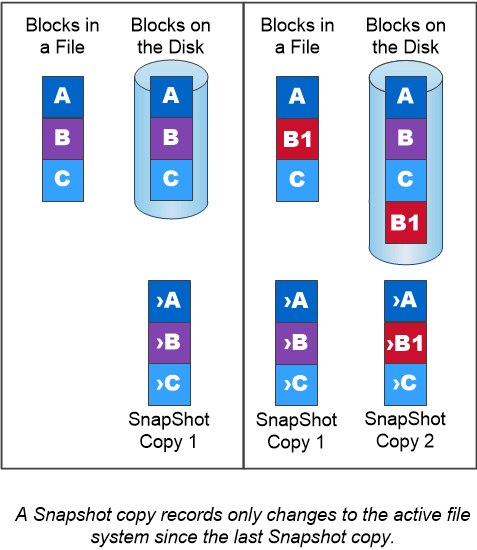Snapshots: including SnapShot Issues and Solutions
Applies to
- ONTAP 9
- Snapshot (Space Management)
Answer
This article contains a list of most SnapShot operational and troubleshooting workflows. However, it is not a comprehensive list.
This can be used to narrow your search to the more commonly utilized troubleshooting KBs, broken down to a specific category.
Overview:
- Data ONTAP running in 7-mode
- ONTAP 9
Known Errors:
[wafl.snap.create.skip.reason:notice]: <volume>: skipping creation of <snapshot.name> snapshot (Snapshot already exists.)[snapmirror.dst.snapDelErr:error]: Snapshot in destination volume <volume> is in use, cannot delete.This Snapshot copy is currently used as a reference Snapshot copy by one or more SnapMirror relationships. Deleting the Snapshot copy can cause future SnapMirror operations to fail.[raid.mirror.resync.snapcrtfail:warning]: Aggregate <aggr_name>: could not create mirror resynchronization snapshot mirror_resync. (No space left on device).
Overview:
A Snapshot copy is a read-only, point-in-time image of a volume. The image consumes minimal storage space and incurs negligible performance overhead because it records only changes to the active file system since the last Snapshot copy.
Snapshot copies owe their efficiency to ONTAP's core storage virtualization technology, its Write Anywhere File Layout (WAFL). Like a database, WAFL uses metadata to point to actual data blocks on disk. But, unlike a database, WAFL does not overwrite existing blocks. It writes updated data to a new block and changes the metadata.
It's because ONTAP references metadata when it creates a Snapshot copy, rather than copying data blocks, that Snapshot copies are so efficient. Doing so eliminates the "seek time" that other systems incur in locating the blocks to copy, as well as the cost of making the copy itself.
You can use a Snapshot copy to recover individual files or LUNs, or to restore the entire contents of a volume. ONTAP compares pointer information in the Snapshot copy with data on disk to reconstruct the missing or damaged object, without downtime or a significant performance cost.
A Snapshot policy defines how the system creates Snapshot copies of volumes. The policy specifies when to create the Snapshot copies, how many copies to retain, and how to label them. For example, a system might create one Snapshot copy every day at 12:10 a.m., retain the two most recent copies, and label them "daily."

Documentation:
Data ONTAP running in 7-mode
Topics such as:
Deleting Snapshot copies automatically
How Snapshot copies work with FlexClone files and FlexClone LUNs
How Snapshot copies work with data compression
How Snapshot copies work with deduplication
How Snapshot copies and Snapshot reserve use space in a volume
Managing aggregate Snapshot copies
And many more
Data Protection Online Backup and Recovery Guide
Topics such as:
Snapshot management
What a Snapshot copy is
User access to Snapshot copies
What Snapshot disk consumption is
And many more
Topics such as:
How much room do you need for Snapshot copies
Deleting busy Snapshot copies
And many more
ONTAP 9
Topics such as:
Viewing the Snapshot copies
Creating Snapshot copies
Scheduling automatic Snapshot copies
And many more
Topics such as:
Creating Snapshot policies
Editing Snapshot policies
Deleting Snapshot policies
And many more
Data protection and disaster recovery > Data Protection > Managing local Snapshot copies
Topics such as:
Working with Snapshot copies
Managing Snapshot policies
Restoring files from the Snapshot copy of a FlexVol volume
And many more
Topics such as:
Restoring a single LUN from a Snapshot copy
Restoring all LUNs in a volume from a Snapshot copy
Deleting one or more existing Snapshot copies from a volume
And many more
Known Errors:
The specific failure symptom can vary depending on your configuration and version of Data ONTAP.
Error:
[wafl.snap.create.skip.reason:notice]: <volume>: skipping creation of <snapshot.name> snapshot (Snapshot already exists.)
Resolution:
AutoSupport message: Scheduled Snapshot create failed
Error:
[snapmirror.dst.snapDelErr:error]: Snapshot in destination volume <volume> is in use, cannot delete.
Resolution:
VSM update fails with the error: '[snapmirror.dst.snapDelErr:error]: Snapshot in destination volume vol01 is in use, cannot delete.'
Error:
This Snapshot copy is currently used as a reference Snapshot copy by one or more SnapMirror relationships. Deleting the Snapshot copy can cause future SnapMirror operations to fail.
Resolution:
Leftover SnapMirror Snapshot could not be deleted after a failed SnapMirror initialization
Error:
[raid.mirror.resync.snapcrtfail:warning]: Aggregate <aggr_name>: could not create mirror resynchronization snapshot mirror_resync. (No space left on device)
Resolution:
SyncMirror could not create resynchronization snapshot / SYNCMIRROR SNAPSHOTS NOT ROTATING.
Additional Information
For more information on Space, see Snapshots size show 0KB in the command line and System Manager.
